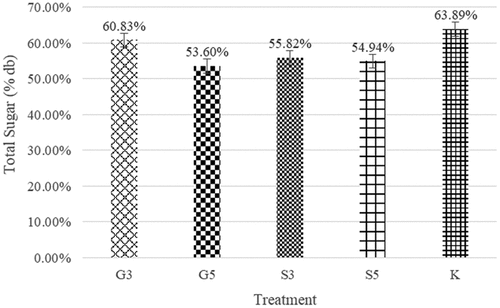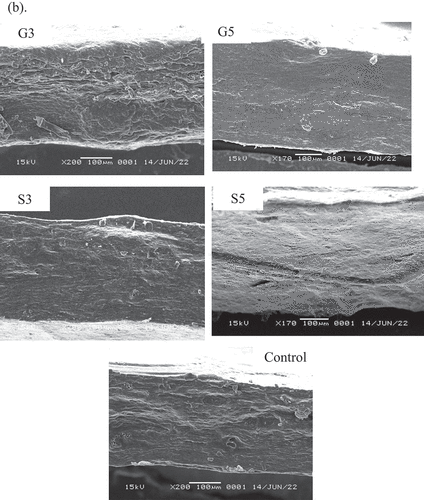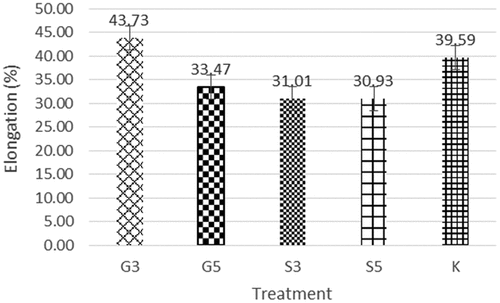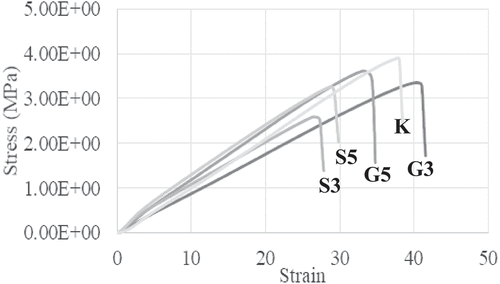 ?Mathematical formulae have been encoded as MathML and are displayed in this HTML version using MathJax in order to improve their display. Uncheck the box to turn MathJax off. This feature requires Javascript. Click on a formula to zoom.
?Mathematical formulae have been encoded as MathML and are displayed in this HTML version using MathJax in order to improve their display. Uncheck the box to turn MathJax off. This feature requires Javascript. Click on a formula to zoom.ABSTRACT
Mango dregs are a by-product that can be used as raw material for fruit leather because of their sufficient fiber and sugar content. The plasticizer forms the desired fruit leather texture that is not brittle and can be rolled up. This study determined the effect of the type and concentration of plasticizer on the physicochemical characteristics of mango dregs fruit leather. This research consisted of four treatments (mango dregs + 3% glycerol (G3); mango dregs + 5% glycerol (G5); mango dregs + 3% sorbitol (S3); mango dregs + 5% sorbitol (S5)) and control (mango dregs). Based on moisture content, hygroscopicity, and hardness results S3 produced the lowest moisture content i.e. 12.89%, hygroscopicity, i.e. 4.8 × 10−3 ±0.16 × 10−3 g H2O/g solid/hour, and hardness i.e. 3456.35 g. Fruit leather with the lowest water activity, reducing sugar, and total sugar was obtained by G5 i.e. 0.426 ± 0.004; 33.82%; and 53.60%, in order. Based on tensile strength, elongation, and Young’s modulus results G3 produced the lowest tensile strength i.e 3.89 MPa, highest elongation i.e. 43.73% and lowest Young’s modulus i.e. 8.88 MPa compared by control sample. Color characteristics show that G3 produced the best characteristics i.e. 57.15 ± 3.747 (L*), 15.33 ± 0.148 (a*), and 48.43 ± 5.765 (b*). Morphological properties by SEM showed that all treated samples exhibited compact, homogeneous, slightly spotted and have layers. The hedonic-quality organoleptic test showed that the mango dregs fruit leathers had a yellow (3.0), slightly strong taste (>2.5), smooth texture (2.8–3.0), and soft (3.0).
Introduction
Mango dregs are part of the mango fruit that can be obtained when separating the mango flesh from the juice. In some food processing industries, such as the fruit juice beverage industry, mango dregs can become a waste. Meanwhile, mango dregs account for 17% of the total weight of the fruit. This figure is large enough to be used as waste. The usage of mango dregs as a raw material for fruit leather can be said to be ideal because mango dregs have high sugar and fiber content, which is one of the considerations in the selection of raw materials for fruit leather (Raab, Citation2000).
The ability to be rolled up and not easily brittle is a required characteristic of fruit leather products. The addition of various types of hydrocolloids and sugar (sucrose) as texture-forming materials has been widely carried out by several previous researchers (Patil et al., Citation2017; Riaño et al., Citation2018). However, the use of hydrocolloids affected the formation of a harder texture (Talay, Citation2019), while according to Fauziyah (Citation2017), consumers preferred chewy fruit leather textures rather than hard ones. Additionally, the addition of sucrose will also affect the increase in sugar content in the final product.
Plasticizers, such as glycerol and sorbitol, are components that can be used as alternatives to improve the texture. Glycerol and sorbitol are also included in sugar alcohols that have a sweet taste intensity that is almost close to sucrose, 0.5–0.7 (Grembecka, Citation2018), with a glycemic index that is much lower than glucose. Afif et al. (Citation2018) stated that plasticizers could disrupt hydrogen bonds between contiguous polymer molecules, therefore, reducing brittleness and increasing polymer film flexibility. Edmund et al. (Citation1965) stated that molecular weight and concentration can be used for comparisons of plasticizer efficiency in most cases. Herudiyanto et al. (Citation2008) reported that a concentration of 3% glycerol produced mango fruit leather with the best characteristics. Winarti et al. (Citation2015) stated that the effective use of sorbitol ranged from 5–20%. However, fruit leather with higher concentrations will affect the stickiness of the product during storage.
The effect of hydrocolloids on fruit leather has been used investigated, but the addition of plasticizer in fruit leather has not been considered. On the other hand, the utilization of mango dregs has not been investigated either. Therefore, this study determined the physicochemical characteristics of mango dregs fruit leather, as a raw material, with the addition of plasticizers of different types and concentrations.
Materials and Methods
Materials
Mango var. Harumanis was obtained from the local market (Majalengka, Indonesia), distilled water, glycerol (MW = 92.094 g/mol), Luff Schoorl reagent, sodium chloride (NaCl), sodium metabisulfite (Na2S2O5) from PT. Brataco, sodium thiosulfate standard solution (Na2S2O3.5 H2O) and sorbitol (MW = 182.17 gm/mol).
Methods
Preparation of Dregs Mango
The mangoes were peeled and washed until clean. The peeled mangoes were soaked in 400 ppm sodium metabisulfite for 5 minutes. Mangoes were cut into smaller sizes and placed into the juicer. 400 grams of mango dregs were weighed. The total soluble solid of mango dregs was calculated with a refractometer in °Brix. Plasticizer was added to 400 grams of mango dregs according to the treatments (3% glycerol (G3); 5% glycerol (G5); 3% sorbitol (S3); 5% sorbitol (S5)) (.). The percentage of plasticizer was calculated based on the total solid weight of mango dregs. Mango dregs were mashed using a food processor for 1 minute. Mango dregs were poured into a stainless-steel baking sheet that has been coated with a baking mate. The thickness of the mango dregs was measured with a caliper of about 3 mm then the mango dregs were dried in a cabinet oven at 60°C for 18 hours.
Table 1. Formulation of mango dregs fruit leather.
Chemical Analysis of Mango Dregs
The analysis of mango dregs as raw material consisted of moisture content, reducing sugar and total sugar using the Luff-Schoorl method, and dietary fiber content using enzymes. Each analysis was carried out in two repetitions Duplo).
Chemical Analysis of Mango Dregs Fruit Leather
The chemical analysis of mango dregs fruit leathers consisted of moisture content (AOAC, 2005), water activity (aw), and reducing sugar and total sugar using the Luff-Schoorl method. Each analysis was carried out in two repetitions (duplo).
Moisture Content
The moisture content of mango dregs fruit leather was analyzed according to AOAC (2005) with the thermogravimetric method. The cup was heated in the oven at 105°C for 1 hour. The hot cup was put in a desiccator for 30 minutes and then weighed and the weight of the cup was recorded (a). 1 gram of the sample was weighed in a constant cup (b). The cup containing the sample was heated in the oven at 105°C for 3 hours and cooled in a desiccator for 30 minutes. The cup was weighed to determine the weight loss of the water during heating. Heated, cooled, and reweighed the cup until constant weight (<0.0005 grams) (c). Moisture content on a dry basis was calculated with Equation 1.
Where; a: constant cup mass (g); b: initial sample mass (g); c: sample + constant cup mass (g)
Water Activity (aw)
Water activity was measured using an AquaLab LITE water activity meter (Koica, Germany). The system was calibrated by placing a supersaturated NaCl salt solution until the aw of the solution showed 0.76. The sample was placed into the plastic cup, then closed aw meter and pressed the “Power” button to start the measurement.
Reducing Sugar
Reducing and total sugar contents were analyzed according to SNI (Indonesian National Standard) with the Luff-Schoorl method. 3 grams of sample were weighed. The sample was dissolved with distilled water and transferred to a 250 ml volumetric flask. Every 5 ml of 5% Pb(CH3COOH)2 solution and 5% NaH2PO4 solution were added. The solution of the 250 ml volumetric flask was homogenized and adjusted to the mark with distilled water. The sample solution was filtered with filter paper. 50 ml of sample filtrate was pipetted and placed in a beaker glass. The sample filtrate was heated until the volume became 25 ml. The filtrate was cooled and then transferred to a 100 ml volumetric flask. The filtrate was adjusted with water and homogenized (Solution A)*.
25 ml of solution A and 25 ml of Luff-Schoorl’s solution were put into an Erlenmeyer. The solution was refluxed for 15 minutes and then cooled. 10 ml of 30% KI and 25 ml of H2SO4 were added to the refluxed solution. The solution was then titrated with standard Na2S2O3.5 H2O until the color of the solution became bright yellow. When the solution changed to a bright yellow color, 10 drops of the starch indicator were added and the solution was titrated again until the color of the solution changed to milky white. The titration volume was recorded as V1. Reducing sugar content was calculated with Equations 2, 3, and 4.
Total Sugar
Solution A, which had been prepared, was pipetted 50 ml into a glass beaker then five drops of methyl orange indicator were added. 20 ml of 4N HCl was added then the solution was heated on the hot plate for 30 minutes. The solution was cooled and transferred to a 100 ml volumetric flask, neutralized with 4N NaOH then adjusted to the limit mark. The solution was prepared for the determination of total sugar (Solution B). 25 ml of solution B and 25 ml of Luff-Schoorl’s solution were put into an Erlenmeyer. The solution was refluxed for 15 minutes and then cooled. 10 ml of 30% KI and 25 ml of H2SO4 were added to the refluxed solution. The solution was then titrated with standard Na2S2O3.5 H2O until the color of the solution became bright yellow. When the solution changed to a bright yellow color, 10 drops of the starch indicator were added and the solution was titrated again until the color of the solution changed to milky white. The titration volume was recorded as V1. Total sugar content was calculated with Formula 2, 3, and 4.
where: A = Volume of sodium thiosulfate; V0 = Volume of titration of sodium thiosulfate against blank; V1 = Volume of titration of sodium thiosulfate to sample; C = Weight of total sugar/reducing sugar (mg); X = Inverted sugar (the result of the conversion of the A value in the luff schoorl table); a = Lower edge of A value (luff schoorl table); b = Top edge of A value (luff schoorl table); Y = Inverted sugar a – inverted sugar b; Dp = Dilution factor (Dp total sugar = 40, Dp reducing sugar = 20); Ws = Weight of sample in mg
Physical Analysis of Mango Dregs Fruit Leather
The physical analysis of mango dregs fruit leathers consisted of scanning electron microscope (SEM), hardness, hygroscopicity rate, color, tensile strength, elongation, and Young’s modulus. Each analysis was carried out two repetitions (duplo).
Scanning Electron Microscope (SEM)
The morphology of mango dregs fruit leather was analyzed using Scanning Electron Microscope (SEM). The Mango dregs sample was placed on the sample grid and covered with carbon tape. The analysis was carried out with JSM−6360 SEM on 100-250× magnification with a voltage of 15kV.
Hygroscopicity Rate
Hygroscopicity rate was analyzed according to GEA Niro Research Laboratory. 1 gram of sample was placed in a cup, then the cup was stored in a desiccator containing a saturated NaCl salt solution with 75% RH at 25°C. The sample was weighed every hour for 5 hours. The hygroscopicity rate was calculated from the slope of moisture content on a dry basis versus the time curve.
Tensile Strength, Elongation, & Young’s Modulus
Tensile strength, elongation, and Young’s modulus were analyzed by the Tensilon UCT−5T, Japan with a speed of 50 mm/min at 25°C, 60% RH. Before testing, the samples were cut with JISK−7113-2-1/2 cutter. The tensile strength values and elongation were measured using the following formula:σ
where: σ = tensile strength (MPa); F = force applied to the material (N); A = area (cm2); ε = elongation (%);ΔL = change in elongation (cm); L = initial length (cm); E = Young’s modulus.
Color
Mango dregs’s color were analyzed by CIELab method with 3 parameters, L* (lightness, 0 = black/100 = white), a* (+a* = redness/-a* = greenness), b* (+b* = yellowness/-b* = blueness). The analysis was measured using Spectrophotometer CM 5 (Konica Minolta Co., Osaka, Japan) with Spectra Magic NX software. The instrument was calibrated using a “zero-calibration” plate and a “white calibration” plate. The sample was placed on a plate with a light hole diameter of 8 mm and the color attributes were captured by the machine.
Hardness
The hardness of mango dregs was analyzed using texture analyzer XT Express (North America) with Exponent Lite Express software. The system was calibrated by selecting “Calibrate Force” on the computer, then clicking “Probe Selection” on the computer and attaching a disk probe with P6 type (6 mm diameter). The sample was placed in the center of the probe and clicked “Run a test.”
Organoleptic Analysis
Organoleptic analysis was carried out using the hedonic-quality analysis method. Four key sensory attributes (color, flavor of mango, texture, and hard bite) were evaluated by trained panelists. Samples were evaluated for panelist preference using a 5-point hedonic scale (.).
Table 2. The 5-point hedonic scale used to assess the organoleptic properties of the mango dregs fruit leather.
Statistical Analysis
The research was conducted experimentally using descriptive statistical analysis. Data were collected from the repeated results of each analysis and expressed as “X ± SD.” The data analysis was carried out with Microsoft Excel software.
Results and Discussion
Mango Dregs Properties
The moisture content of the mango dregs was 89.68%. The reduced sugar content of mango dregs was 4.91%. The result of this study was higher than Elbandy et al. (Citation2014). The main components of sugar in mango dregs are glucose, fructose, and sucrose different amounts based on the variety and level of maturity (Li et al., Citation2020). The total sugar content of mango dregs in this study was 6.53% (.). The difference between total sugar and reducing sugar, which is the content of nonreducing sugar in the mango dregs, was 1.62%. From these results, it can be seen that the reducing sugar content of the mango dregs is much higher than that of the non-reducing sugar.
Table 3. Properties of mango dregs.
Based on . the dietary fiber content of mango dregs is 0.65% consisting of soluble fiber (SDF) and insoluble fiber (IDF). Campbell (Citation2018) reported that 61% of the total mango fiber was soluble fiber, while 39% was insoluble fiber. The type of soluble fiber found in mangoes is pectin. The fiber content in mango dregs affects the physical characteristics of the final product (Ayu et al., Citation2020). In this research, the fiber content of mango dregs significantly affected the SEM results and fruit leather texture in organoleptic tests. The presence of fibers affects the surface morphology and texture of the fruit leather. However, the fiber content also affects the increase in the moisture content of fruit leather because the fiber absorb and retains water. Soluble fibers have large polymer-shaped molecule complex, large water-binding capacity, and many free hydroxyl groups. The free hydroxyl groups polar in fiber have multiple matrix structures that provide an opportunity for the binding of water through hydrogen bonds. A high content of fiber in the materials increases the moisture content of product (Darojat, 2010s).
Chemical Properties of Mango Dregs Fruit Leather
Moisture Content
The moisture content of mango dregs fruit leather was in the range of 12.89–14.31% (dry basis) (.). The control (K) sample had a higher moisture content than the treated sample (G3, G5, S3, S5). The presence of plasticizers increases the total number of solids in the product, and the presence of water decreases. The moisture content was found to decrease with an increase in the concentration of plasticizer, i.e. G5 (13.85%) and G3 (14.01%).
Figure 1. Moisture content of mango dregs fruit leathers in dry basis *The graph shows the mean values of the two replicates and the vertical bars represent the standard error values of the replicates.
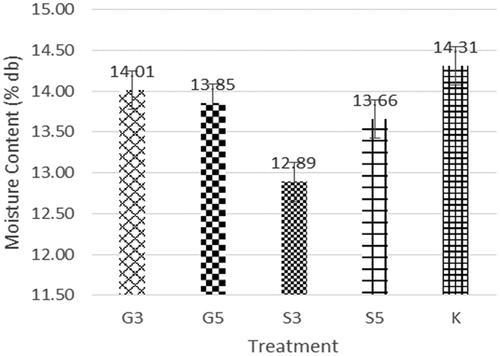
The type of plasticizer affects the moisture content of the mango dregs fruit leather. Mango dregs fruit leather with glycerol (G3 & G5) had a higher moisture content than mango dregs fruit leather with sorbitol (S3 & S5). The hydroxyl group in glycerol has a strong affinity for binding water molecules, which caused fruit leather with glycerol form hydrogen bonds in the matrix (Cerqueira et al., Citation2012; Sanyang et al., Citation2016). Syafiq et al. (Citation2022) reported the same results, starch films with the addition of glycerol (G-plasticized films) had a higher moisture content than starch films with the addition of sorbitol (S-plasticized films).
The moisture content of mango fruit leather in several other studies is > 15% with a range of 28.64–32.79% (Anggita et al., Citation2019); 29.86–33.8% (Panigoro et al., Citation2020) and 19.95–25.95% (Hadi et al., Citation2020). In this research, the moisture content of the mango dregs fruit leather was lower, < 15%. Apart from the use of plasticizers as additives, mango fruit varieties (Panigoro et al., Citation2020) and long drying times (Hadi et al., Citation2020) cause differences in the moisture content of the final product.
Water Activity (aw)
The water activity of mango dregs fruit leather was in the range of 0.43–0.49 (.). Samples with glycerol (G3 and G5) had lower water activity values than samples with sorbitol (S3 and S5). As stated by Sanyang et al. (Citation2016) that the hydroxyl group on glycerol has a strong affinity for binding water molecules. The water contained in the product is in a bound state so that the availability of free water is low.
Figure 2. Water activity of mango dregs fruit leathers. *The graph shows the mean values of the two replicates and the vertical bars represent the standard error values of the replicates.
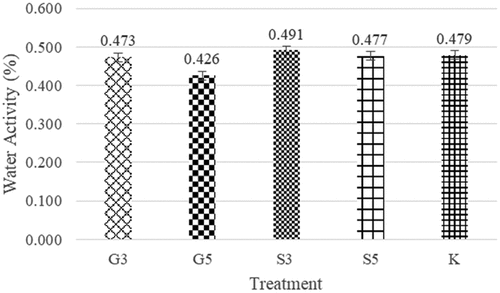
Mango dregs fruit leather samples with higher concentrations of plasticizer (G5 & S5) had lower aw values than samples with lower concentrations (G3 & S3). According to Gliemmo et al. (Citation2006) humectants can bind water because of the presence of hydrophilic groups capable of forming hydrogen bonds with water molecules to reduce the presence or availability of free water in the product. The more the concentrations of glycerol and sorbitol in each sample, the stronger the hydrogen bonds that occur.
Reducing Sugar
Based on . the reducing sugar content of mango dregs fruit leather was in the range of 33.82–44.70% (dry basis). The control sample (K) had a higher reducing sugar content than the treated sample (G3, G5, S3, S5). The plasticizer does not effect on increasing reducing sugars because the plasticizer is a polyhydric alcohol which is made from hydrogenated glucose. Furthermore, Winarno (Citation1997) stated that the presence of reducing properties of a sugar molecule is determined by the presence of free and reactive hydroxyl (OH), aldehyde (−CHO) or ketone (−CO) groups. Plasticizer does not have aldehyde or ketone groups (Grembecka, Citation2018).
Figure 3. Reducing sugar of mango dregs fruit leathers. *The graph shows the mean values of the two replicates and the vertical bars represent the standard error values of the replicates.

The effect of a plasticizer on reducing the reducing sugar content of mango dregs fruit leather is related to an increase in the number of dissolved solids. The increase in total solids occurs because free water is bound by the plasticizer and causes the concentration of dissolved materials to increase (Farikha et al., Citation2013). Additionally, according to Houwink’s (Citation1947) concept of plasticization, during the plasticization process by plasticizers most of the molecular chains of molecules contain homopolar bonds, whereas between chains all types of bonds is posible (Marcilla and Beltrán, Citation2012). This indicates that the formation of interactions between the hydroxyl groups of the plasticizer and the hydroxyl groups of other components, such as glucose in the dregs, can occur. The interaction, as reported by Fitantri et al. (Citation2014), reduce the presence of glucose-free hydroxyl groups in the product, so that these hydroxyl groups cannot participate in the aspiration to reduce oxidizing compounds such as ferrinicides, hydrogen peroxide or cupric ion (Cu2+). The polarity of the polymer and plasticizer is a factor that can determine the number of bonds that occur (Marcilla and Beltrán, Citation2012).
Mango dregs fruit leather samples with higher plasticizer concentrations (G5 & S5) had lower reducing sugar content than the samples with lower plasticizer concentrations (G3 & S3). These results are by following under the research of Suseno et al. (Citation2008). Compared with Anggita et al. (Citation2019) that has a range of reducing sugar levels in mango fruit leather of 43.43–58.01%, the reducing sugar content in this research is lower
Total Sugar
The total sugar content of mango dregs fruit leather was in the range of 53.60–63.89% (dry basis) (.). The control sample (K) had a higher total sugar content than the treated sample (G3, G5, S3, S5). Plasticizer produced fruit leather with lower sugar content. Based on other studies, the total sugar content in mango fruit leather i.e. 58.6% (Panigoro et al., Citation2020) and 68.63% (Hadi et al., Citation2020). According to Naknaen et al. (Citation2016), the presence of plasticizer reduced the ratio of sucrose in the product due to the interaction between both, plasticizer and sucrose. Reducing the amount of sucrose reduces the substrate in the sucrose inversion reaction. Mango dregs fruit leather samples with higher concentrations of plasticizer (G5 and S5) had lower total sugar content than samples with lower concentrations (G3 & S3). The higher concentration of plasticizer added, the higher the interaction between the plasticizer and sucrose, this makes the amount of sucrose in the sample lower.
Physical Properties of Mango Dregs Fruit Leather
SEM
Based on the results of the SEM with a magnification of 100× (), in general, mango dregs fruit leathers had relatively compact, homogeneous surfaces, slightly speckled, and layers. According to Fahrullah et al. (Citation2020) white spots indicated that the intermolecular bonds were rather weak. The surfaces of mango dregs fruit leather between the control sample and the treated samples (G3, G5, S3, S5) did not show any significant differences. However, the appearance of the cross-section when the samples were cut (), it can be seen that there were differences between the samples. Sample G3 and the control (K) had rougher surfaces than the other samples (G5, S3, S5). The rough surface might be due to the presence of fibers that had not been completely homogenized.
Figure 5a. (a) Morphology Structure of mango dregs fruit leathers surfaces (b) Cross-sectional appearance of the surface of the mango dregs fruit leathers.
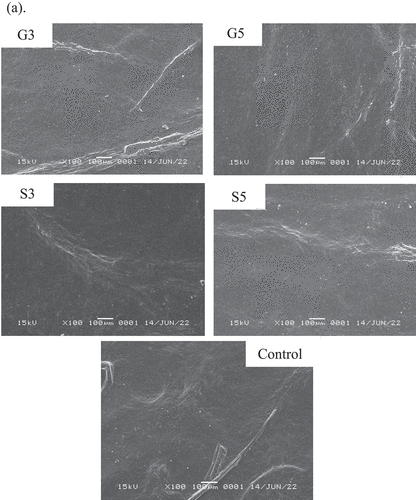
From the results of the SEM analysis, the addition of plasticizers affects the morphological structure of the mango dregs fruit leathers. As stated by Afifah et al. (Citation2018) that when plasticization occurs by plasticizers, there is a change in the structural composition of the product surface that makes the surface more compact. Additionally, a compact surface is formed due to interactions through hydrogen bonds hydroxyl groups (OH) between components (Kaushik and Kaur, Citation2016). shows that different types of plasticizers affect the surface morphology of the samples. The surface morphology of the mango dregs fruit leather treated with sorbitol (S3 & S5) appeared more homogeneous than the samples with glycerol (G3 & G5). Sorbitol had stable hydrogen bonds with the components contained in raw material (Fahrullah et al., Citation2020). A higher concentration of plasticizer produced more homogeneous morphological structure.
Hygroscopicity Rate
The hygroscopicity rate of mango dregs fruit leather was in the range of 0.0044–0.0081 g H2O/g dry basis/hour (.). The control sample showed the lowest value (0.0044 H2O/g dry basis/hour) and the highest value was G5 (0.0081 g H2O/g dry basis/hour). The addition of plasticizer increased the hygroscopicity of mango dregs fruit leather products. When plasticizer molecules in polymer are heated above the glass transition temperature, the heat energy increases, and the polymer chains separate creating more free volume. When the free volume increases, the freedom of movement of the polymer chains occurs, and there is also an increase in the diffusivity of water vapor which accelerated water vapor transmission (Farhan and Hani, Citation2017).
Figure 6. Hygroscopicity rate of mango dregs fruit leathers. *The graph shows the mean values of the two replicates and the vertical bars represent the standard error values of the replicates.
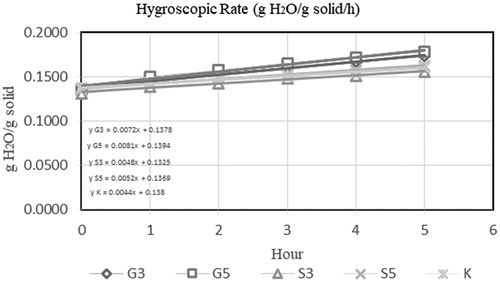
Different types of plasticizer affect the hygroscopicity rate characteristics of mango dregs fruit leather. The fruit leather samples with the addition of glycerol (G3 & G5) had a higher hygroscopicity rate than the fruit leather samples with sorbitol (S3 & S5). Karbowiak et al. (Citation2006) and Kristo and Biliaderis (Citation2006) stated that glycerol is a very hygroscopic molecule when compared to sorbitol. Glycerol has lower molecular weight (92,094 g/mol) than sorbitol (182.17 g/mol). In addition, the hygroscopicity of the glycerol sample is might be related to the moisture content of the glycerol sample which is greater than that of the sorbitol sample.
Mango dregs fruit leather samples with a 5% plasticizer had a higher hygroscopicity rate than samples with 3% plasticizer. An increasing amount of plasticizer, product characteristics such as tensile strength, Young’s modulus, and glass transition temperature (Tg) decreased while elongation and gas permeability increased (Suderman et al., Citation2018).
Tensile Strength
The tensile strength of mango dregs fruit leather was in the range of 3.46–4.06 MPa. Samples with treatment (G3, G5, S3, S5) had a lower value than the control sample (K) (.). The plasticizer reduced the value of the tensile strength of fruit leather, because of the plasticizer reducing the surface tension between polymer chains and the formation of free volume through the plasticization process (Marcilla and Beltrán, Citation2012). The results in this study conform with several studies (Hazrati et al., Citation2021; Sanyang et al., Citation2015).
Figure 7. Tensile strength of mango dregs fruit leathers. *The graph shows the mean values of the two replicates and the vertical bars represent the standard error values of the replicates.
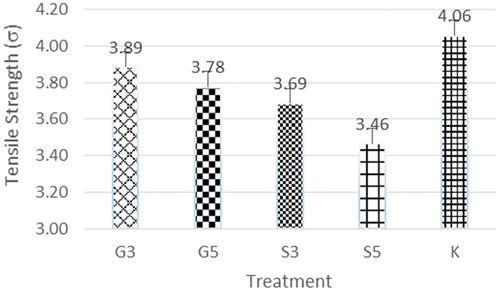
Fruit leather with glycerol (G3 & G5) had a higher tensile strength value than fruit leather with sorbitol (S3 & S5). Gabriel et al. (Citation2021) stated that sorbitol needs to be supported with certain fillers to increase the tensile strength of the product. These results are also in line with the research conducted by Jantrawut et al. (Citation2017). The sample with 3% of plasticizer (G3 & S3) had a higher tensile strength value than the sample with 5% (G5 & S5).
Elongation
Based on . the elongation value of mango dregs fruit leather was in the range of 30.93–43.73%. The elongation values of the treated samples (G5, S3, S5) were lower than the control sample (K). It can be explained by the anti-plasticization theory. Anti-plasticization is an anomalous process that occurs in plasticizers in polymers, resulting in product characteristics inversely proportional to the effect of plasticization, one of which is a decrease in elongation (Kinjo and Nakagawa, Citation1973). Anti-plasticization can occur due to the small amount of plasticizer (Mascia et al., Citation2020). It can be seen in . where the treated sample shows a linear graph. The linear graph on the stress-strain curve shows the elastic region, which means the product can return to its original shape when the force is removed. It is indicated that the samples undergo separation before they reached the plastic region. The increase in the concentration of plasticizer from 3% to 5%, the elongation value of fruit leather decreased from 43.73% to 33.46% for the glycerol treatment (G3 & G5) and 31.01% to 30.93% for the sorbitol treatment (S3 & S5).
Young’s Modulus
Young’s modulus of the mango dregs fruit leather was in the range of 8.88–12.14 MPa (.). The control sample (K) has a higher value than samples G3 and S3, meanwhile it was lower than samples G5 and S5. In theory, the presence of plasticizers decreases the value of the Young’s modulus due to the plasticization process. The Young’s modulus value is related to the tensile strength value and the percentage of elongation. The young’s modulus was linear with tensile strength and inversely proportional to the percent elongation. If the Young’s modulus and tensile strength decreased, the flexibility of the products increased. In this research, the interaction between the three parameters is shown by the G3 sample with the control as a comparison. The other samples showed the opposite result. Apart from the anti-plasticization process occurs, another possible factor that affecting this result is moisture content of G3 sample. The moisture content of the G3 sample is greater than the other treated samples (G5, S3, S5). Pittia and Sacchetti (Citation2008) stated that the moisture content in the material can also act as a plasticizer, and because of that the ability to plasticizer is higher than materials with low moisture content.
Figure 10. Young’s Modulus Curve of Mango Dregs Fruit Leather: G3 = mango dregs with 3% glycerol; G5 = mango dregs with 5% glycerol; S3 = mango dregs with 3% sorbitol; S5 = mango dregs with 5% sorbitol; K = mango dregs.
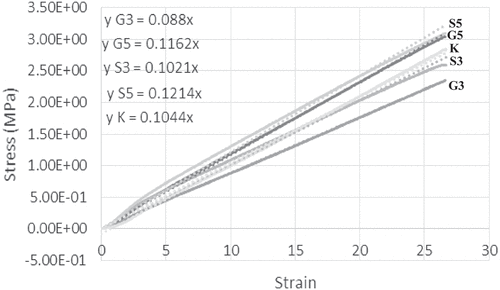
Samples treated with glycerol (G3 & G5) had a lower Young’s modulus than samples with sorbitol (S3 & S5). The molecular weight of sorbitol is greater than that of glycerol, the bonding process between polymers is stronger. The strong bond between the plasticizer and the product can increase the stiffness of the product so that the value of the modulus of elasticity of the product increases larger. These results are in accordance with the research conducted by Darni et al. (Citation2017) and Marcilla and Beltrán (Citation2012). Darni et al. (Citation2017) reported that edible films with the addition of sorbitol are hard and brittle polymers, while edible films with glycerol are soft and weak.
Color
Based on . in general, the brightness level (L*) of the samples was in the range of 48.88–58.07. The presence of plasticizer did not significantly affect the brightness of mango dregs fruit leather. The plasticizer is a colorless liquid (Moody and Needles, Citation2004), also stated by Dwivedi (Citation1991) and Basiak et al. (Citation2018) that sorbitol and glycerol are chemically unreactive, have high-temperature resistance and do not participate in Maillard reactions. The addition of sodium metabisulfite during the process might be maintained the brightness value of the product. Sodium metabisulfite is an inhibitor of the polyphenol oxidase enzyme which inhibited the enzymatic browning. Based on other studies, the brightness level of mango fruit leather were 46.07–52.97 (Azeredo et al., Citation2006); 52.31–53.34 (Pushpa et al., Citation2013); 59.01–61.88 (Effah-Manu et al., Citation2013); and 57.2 (Mphaphuli et al., Citation2020).
Figure 11. Color characteristics of mango dregs fruit leathers; (a) brightness (L*); (b) redness (a*); (c) yellowness (b*). *The graph shows the mean values of the two replicates and the vertical bars represent the standard error values of the replicates.

Based on . the redness value of mango dregs fruit leathers was in the range of 11.96–16.56. The redness value was found to increase with an increase in the concentration of the plasticizer. Added plasticizer, as a humectant, may increase the browning by contributing toward increased total solids as reported by Chen and Mahony (Citation2016). Increased total solid may also affecting opacity of the product. Martin et al. (Citation2016) reported that there is an interaction between plasticizer and starch which affected the characteristics of the film, including opacity. The range of a* fruit leather mangoes in several other studies were 7.87–9.07 (Azeredo et al., Citation2006); 9.85–11.07 (Pushpa et al., Citation2013); 12.99–14.90 (Effah-Manu et al., Citation2013) and 5.8 (Mphaphuli et al., Citation2020).
Based on , b* (yellowness) value of mango dregs fruit leathers were in the range of 36.26–49.67. The yellowness is obtained from the carotenoid pigments found in mangoes naturally. The control sample shows the highest value (49.67%). The addition of plasticizer reduces the yellowness of samples. In connection with the increase in total solids with the addition of plasticizers, the treated samples had a lower b* value than the control sample. The range of b* mango fruit leather in several studies were 34.80–42.18 (Azeredo et al., Citation2006); 20.95–26.55 (Pushpa et al., Citation2013); 38.98–47.77 (Effah-Manu et al., Citation2013) and 39.8 (Mphaphuli et al., Citation2020).
Hardness
The hardness level of mango dregs fruit leathers was in the range of 2745.57–4262.78 g (.). The control sample (K) produced the lowest hardness level compared to the treated samples (G3, G5, S3, S5). The presence of plasticizer increased the level of product hardness (Lim and Hoag, Citation2013). Plasticizer disrupts and changes the molecular chain network resulting in a more free volume that then increases film thickness (Ibrahim et al., Citation2019; Karki, Citation2011; Sanyang et al., Citation2016).
Figure 12. Hardness of mango dregs fruit leathers. *The graph shows the mean values of the two replicates and the vertical bars represent the standard error values of the replicates.
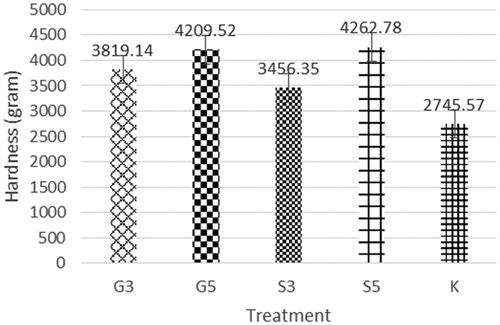
Additionally, hardness level can be related to the moisture content of the product. The higher the moisture content, the hardness decreases. During heating, the water lost in the material increases, bonds between the matrix materials become tighter and affect the texture of the product, which increased the product’s hardness (Puspaningrum et al., Citation2018). Control samples (K) that have higher moisture content have lower hardness levels. Different types of plasticizer had no effect on the hardness of the mango dregs fruit leather. However, increasing the concentration of plasticizer can increase the hardness level of the mango dregs fruit leather. A lower concentration of plasticizer (3%) gave a weaker binding effect than a higher concentration of plasticizer (5%). When the intermolecular bonds are weak, the hardness of the product is low.
Organoleptic Properties
The results of the hedonic-quality test assessment by the panelists on the color parameters of the mango dregs fruit leathers indicated that the average rating was on a scale of 3. Scale 3 shows that the color of the mango dregs fruit leathers for all treatments was yellow. For the distinctive taste of mango parameters from the mango dregs fruit leather, it shows that the average rating was on a scale > 2.5. A scale of 2.5 indicated that the mango dregs fruit leathers for all treatments had slightly strong taste. For the texture parameter, mango dregs fruit leathers shows that the average rating was on a scale of 2.8–3.0. Samples with higher level of smoothness were samples S3 and S5, which reached 3. Based on statistical tests of analysis of variance, the color, taste, and texture parameters of the mango dregs fruit leathers had Fvalue< Fcount, which means there was no significant difference between the three treatments.
Based on . the hardness to bite parameter of mango dregs fruit leathers indicated that the average rating was on a scale of 2.0–3.0. Based on the results of the statistical analysis of variance, the hardness to bite was significantly different between the five treatments, so further tests were carried out with Duncan’s test. Based on Duncan’s test, sample G3 was the most different sample compared to the other samples in the panelists preference. These results indicated that according to 24 panelists, the G3 sample had the characteristics of soft bite, while the other samples (G5, S3, S5, and Control) had slightly hard characteristics.
Table 4. Sensory attributes of mango dregs fruit leather.
Conclusion
The plasticizer affects the characteristics of moisture content, reducing sugar, total sugar, morphological structure (SEM), hygroscopicity rate, hardness, tensile strength, yellowness level (b*) and bite strength of the organoleptic mango dregs fruit leathers. The morphology of mango dregs fruit leather is compact, homogeneous, slightly spotted and has layers. The antiplasticization process occurs in samples G5, S3, and S5 for elongation and young’s modulus characteristics. The hedonic-quality organoleptic test showed that the mango dregs fruit leathers had a yellow (3.0), slightly strong taste (>2.5), smooth texture (2.8–3.0), and soft (3.0). The best treatment was obtained in fruit leather with 3% glycerol (G3).
Disclosure statement
No potential conflict of interest was reported by the authors.
References
- Afifah, N., E. Sholichah, N. Indrianti, P. Pengembangan, T. Tepat, G. Lipi, J.K.S. Tubun, and N. Subang. 2018. Pengaruh kombinasi plasticizer terhadap karakteristik edible film dari karagenan dan lilin lebah. Biopropal Industri 9(1):49–60.
- Afif, M., N. Wijayati, and S. Mursiti. 2018. Pembuatan dan Karakterisasi Bioplastik dari Pati Biji Alpukat-Kitosan dengan Plasticizer Sorbitol. Indonesian J. Of Chemical Sci. 7(2):102–109.
- Anggita, D., F.S. Rejeki, and E.R. Wedowati. 2019. Proporsi mangga podang-pisang kepok dan konsentrasi jeruk nipis terhadap karakteristik fruit leather mangga. J. Of Research And Techn. 5(2):178–190.
- Ayu, D.F., O.S. Rumengan, and U. Pato (2020). Combination of Pineapple and Okra on Chemical and Sensory Characteristics of Fruit Leather. International Conference of Sustainability Agriculture and Biosystem, 6–12. 10.1088/1755-1315/515/1/012049
- Azeredo, E.S., G.E.G. Brito, V.L. Moreira, L.M. Bruno, and L.M. Bruno. 2006. Effect of drying and storage time on the physicochemical properties of mango leathers. Int. J. Food Sci. Tech. 41(6):635–638. doi: 10.1111/j.1365-2621.2005.01120.x.
- Basiak, W., A. Lenart, and F. Debeaufort. 2018. How Glycerol and Water Contents Affect the Structural and Functional Properties of Starch-Based Edible Films. Polymers 10(412):1–18. doi: 10.3390/polym10040412.
- Campbell, M. 2018. Soluble Fiber in Mangoes. SFGATE. https://healthyeating.sfgate.com/soluble-fiber-mangoes-5414.html
- Cerqueira, M.A., B.W.S. Souza, J.A. Teixeira, and A.A. Vicente. 2012. Effect of glycerol and corn oil on physicochemical properties of poly_saccharide films – a comparative study. Food Hydrocoll 27(1):175–184. doi: 10.1016/j.foodhyd.2011.07.007.
- Chen, B., and J.A.O. Mahony. 2016. Impact of glucose polymer chain length on heat and physical stability of milk protein-carbohydrate nutritional beverages. Food Chem. 211:474–482. doi: 10.1016/j.foodchem.2016.04.090.
- Darni, Y., H. Utami, R. Septiana, and R. Aidila. 2017. Comparative Studies of the Edible Film Based on Low Pectin Methoxyl with Glycerol and Sorbitol Plasticizers. J. Bahan Alam Terbarukan 6(2):158–167. doi: 10.15294/jbat.v6i2.9707.
- Dwivedi, B.K. 1991. Sorbitol. In: L.C. Nabor and R.C. Gelardi. eds. Alternative Sweeteners. 2nd. Marcel Dekker Inc
- Edmund, H., H. Immergut, and H.F. Mark. 1965. Principles of Plasticization. In Plasticization and Plasticizer Processes. American Chemical Societypp. 1–26 10.1021/ba-1965-0048.ch001
- Effah-Manu, L., I. Oduro, and A. Addo. 2013. Effect of Dextrinized Sweet potatoes on the Physicochemical and Sensory Quality of Infra-Red Dried Mango Leather. J. Of Food Processing & Tech. 4(5):1–5. doi: 10.4172/2157-7110.1000230.
- Elbandy, M., S. Abed, and G.A. Fadeel. 2014. Aloe vera Gel as a Functional Ingredient and Natural Preservative in Mango Nectar. World J. Of Dairy & Food Sci. 9(February 2015):191–203. doi: 10.5829/idosi.wjdfs.2014.9.2.1139.
- Fahrullah, F., L.E. Radiati, P. Purwadi, and D. Rosyidi. 2020. The effect of different plasticizers on the characteristics of whey composite edible film. J. Ilmu Dan Teknologi Hasil Ternak 15(1):31–37. doi: 10.21776/ub.jitek.2020.015.01.4.
- Farhan, A., and N.M. Hani. 2017. Characterization of Edible Packaging Films Based on Semi-refined Kappa-carrageenan Plasticized with Glycerol and Sorbitol. Food Hydrocoll 64:48–58. doi: 10.1016/j.foodhyd.2016.10.034.
- Farikha, I.N., C. Anam, and E. Widowati. 2013. Pengaruh jenis dan konsentrasi bahan penstabil alami terhadap karakteristik fisikokimia sari buah naga merah (hylocereus polyrhizus). J. Teknosains Pangan 2(1):30–38.
- Fauziyah, E. 2017. Consumer Preference Towards Fruit Leather Attributes of Madurese Exotic Tropical Fruit. Inter. Res. J. Of Business Studies 10(2):111–122. doi: 10.21632/irjbs.10.2.111-122.
- Fitantri, A.L., N.H.R. Parnanto, and D. Praseptiangga. 2014. Kajian karakteristik fisikokimia dan sensoris fruit leather nangka (artocarpus heterophyllus) dengan penambahan karaginan. J. Teknosains Pangan 3(1):26–34.
- Gabriel, A.A., A.F. Solikhah, and A.Y. Rahmawati. 2021. Tensile Strength and Elongation Testing for Starch-Based Bioplastics using Melt Intercalation Method: A Review. J. Phys. 1858(1):012028. doi: https://doi.org/10.1088/1742-6596/1858/1/012028.
- Gliemmo, M.F., C.A. Campos, and L.N. Gerschenson. 2006. Effect of several humectants and potassium sorbate on the growth of Zygosaccharomycesbailii in model aqueous systems resembling low sugar products. J Food Eng 77(4):761–770. doi: 10.1016/j.jfoodeng.2005.08.001.
- Grembecka, M. 2018. Sugar Alcoholspp. 1–10. Encyclopedia of Analytical Science. Elsevier Inc, 10.1016/B978-0-12-409547-2.14094-6.
- Hadi, K.U.A.K., N. Suhartatik, and Y.A. Widanti. 2020. Fruit leather dari beberapa jenis mangga (Mangifera Indica L .) dengan perbedaan konsentrasi. JITIPARI 5(2):26–36. doi: 10.33061/jitipari.v5i2.4069.
- Hazrati, K.Z., S.M. Sapuan, M.Y.M. Zuhri, and R. Jumaidin. 2021. Effect of plasticizers on physical, thermal, and tensile properties of thermoplastic films based on Dioscorea hispida starch. Int. J. Biol. Macromol. 185:219–228. doi: 10.1016/j.ijbiomac.2021.06.099.
- Herudiyanto, M., S. Sekar, and S. Cucu. 2008. Pengaruh imbangan mangga kweni (mangifera odorata griff.) dengan wortel (Daucus Carota L.) serta penambahan gliserol terhadap beberapa karakteristik fruit leather. TEKNOTAN. 2(1).
- Houwink. (1947). No Title. Proc. XI Int., 575–583.
- Ibrahim, M.I.J., S.M. Sapuan, E.S. Zainudin, and M.Y.M. Zuhri. 2019. Physical, thermal, morphological, and tensile properties of cornstarch-based films as affected by different plasticizers. Int. J. Food Prop. 22(1):925–941. doi: 10.1080/10942912.2019.1618324.
- Jantrawut, P., T. Chaiwarit, K. Jantanasakulwong, C. Brachais, and O. Chambin. 2017. Effect of Plasticizer Type on Tensile Property and in vitro Indomethacin Release of Thin Films Based on Low-Methoxyl Pectin. Polymers 9(289):1–14. doi: https://doi.org/10.3390/polym9070289.
- Karbowiak, T., H. Hervet, L. Leger, D. Champion, F. Debeaufort, and A. Voilley. 2006. Effect of Plasticizers (Water and Glycerol) on the Diffusion of a Small Molecule in Iota-Carrageenan Biopolymer Films for Edible Coating Application. Biomacromolecules 7(6):2011–2019. doi: 10.1021/bm060179r.
- Karki, M. 2011. Evaluation of fruit leathers made from New Zealand grown blueberries. Lincoln University, Lincoln, New Zealand.
- Kaushik, A., and R. Kaur. 2016. Thermoplastic starch nanocomposites reinforced with cellulose nanocrystals: Effect of plasticizer on properties. Compos. Interface. 6440:1–17. doi: 10.1080/09276440.2016.1169487.
- Kinjo, N., and T. Nakagawa. 1973. Antiplasticization in the Slightly Plasticized Poly (vinyl chloride). Polymer Journal 4(2):143–153. doi: 10.1295/polymj.4.143.
- Kristo, E., and C.G. Biliaderis. 2006. Water sorption and thermo-mechanical properties of water/sorbitol-plasticized composite biopolymer films: Caseinate – pullulan bilayers and blends. Food Hydrocoll 20(7):1057–1071. doi: 10.1016/j.foodhyd.2005.11.008.
- Lim, H., and S.W. Hoag. 2013. Plasticizer Effects on Physical – Mechanical Properties of Solvent Cast Soluplus ® Films. Aaps Pharmscitech 14(3):13–16. doi: 10.1208/s12249-013-9971-z.
- Li, L., H. Wu, X. Ma, W. Xu, Q. Liang, R. Zhan, and S. Wang. 2020. Transcriptional mechanism of di ff erential sugar accumulation in pulp of two contrasting mango (Mangifera indica L .) cultivars. Genomics 112(6):4505–4515. doi: 10.1016/j.ygeno.2020.07.038.
- Marcilla, A., and M. Beltrán. 2012. Mechanisms of Plasticizers Action. In Handbook of Plasticizers. ChemTec Publishingpp. 119–133. 10.1016/B978-1-895198-50-8.50007-2
- Martin, A.A., G. Linde, and D.C. Dragunski. 2016. Effect of Plasticizer and Modified Starch on Biodegradable Films for Strawberry Protection. J. Of Food Processing & Preservation. doi: 10.1111/jfpp.13063.
- Mascia, L., Y. Kouparitsas, D. Nocita, and X. Bao. 2020. Antiplasticization of Polymer Materials: Structural Aspects and Effects on Mechanica. Polymers 12(769):1–36. doi: 10.3390/polym12040769.
- Moody, V., and H.L. Needles. 2004. Polyvinyl Chloride Plastisol Coatin. In: W. Andrew. ed. Tufted Carpetpp. 115–123. https://doi.org/10.1016/B978-1-884207-99-0.50011-7
- Mphaphuli, T.E., R. Sultanbawa, Y. Slabbert, D. Sivakumar, and D. Sivakumar. 2020. Enrichment of Mango Fruit Leathers with Natal Plum (Carissa macrocarpa) Improves Their Phytochemical Content and Antioxidant Properties. Foods 9(4):1–14. doi: 10.3390/foods9040431.
- Naknaen, P., R. Maneyam, and A. Kam-Onsri. 2016. Effect of Partial Replacement of Sucrose with Humectant in the Osmotic Solution on the Characteristics of Osmo-Dried Cantaloupe. Int. J. Fruit Sci. 8362(3):241–225. doi: 10.1080/15538362.2015.1087359.
- Panigoro, Y., Z. Antuli, and M. Limonu. 2020. Karakterisasi Fisikokimia dan Sensori Fruit Leather Hasil Formulasi Mangga Arum manis (Mangifera indica L. var arum manis) dan Pisang Goroho (Musa acuminate sp.). Jambura J. Of Food Tech. 2(1):1–10.
- Patil, S.H., P.D. Shere, A.R. Sawate, and B.S. Mete. 2017. Effect of hydrocolloids on textural and sensory quality of date-mango leather. J. Of Pharmacognosy And Phytochemistry 6(5):399–402.
- Pittia, P., and G. Sacchetti. 2008. Antiplasticization effect of water in amorphous foods. A review. Food Chem. 106(4):1417–1427. doi: 10.1016/j.foodchem.2007.03.077.
- Pushpa, G., P. Rajkumar, Y. Gariepy, and G.S.V. Raghavan. 2013. Microwave Drying of Enriched Mango Fruit Leather Microwave Drying of Enriched Mango Fruit Leather. The Canadian Society For Bioengineering. doi: 10.13031/2013.22129.
- Puspaningrum, L., S.S. Yuwono, and E. Martati. 2018. Karakteristik fisikokimia dan sensoris fruit leather apel manalagi (malus sylvestris mill) dengan subtitusi pisang candi (musa paradisiaca). J. Teknologi Pertanian 19(3):173–182. doi: 10.21776/ub.jtp.2018.019.03.4.
- Raab, C. 2000. Making Dried Fruit Leather, In: Extention Foods and Nutrition. Oregon State University. Oregon State University.
- Riaño, A.M.S., H. Patricia, H.P.B. Andrade, and C.P.V. Real. 2018. Incidence of hydrocolloid type on quality parameters in mango leathers (Mangifera indica L .) Yulima variety. Food Sci. And Tech. 3(1):109–115. Incidence. doi: 10.1590/fst.16917.
- Sanyang, M.L., S.M. Sapuan, M. Jawaid, M.R. Ishak, and J. Sahari. 2015. Ffect of Plasticizer Type and Concentration on Tensile, Thermal and Barrier Properties of Biodegradable Films Based on Sugar Palm (Arenga pinnata) Starch. Polymers 7(6):1106–1124. doi: 10.3390/polym70x000x.
- Sanyang, M.L., S.M. Sapuan, M. Jawaid, M.R. Ishak, and J. Sahari. 2016. Effect of plasticizer type and concentration on physical properties of biodegradable films based on sugar palm (arenga pinnata) starch for food packaging. J Food Sci Technol 53(1):326–336. doi: 10.1007/s13197-015-2009-7.
- Suderman, N., M.I.N. Isa, and N.M. Sarbon. 2018. The effect of plasticizers on the functional properties of biodegradable gelatin-based fi lm: A review. Food Bioscience 24:111–119. doi: 10.1016/j.fbio.2018.06.006.
- Suseno, T.I.P., N. Fibria, and N. Kusumawati. 2008. Pengaruh penggantian sirup glukosa dengan sirup sorbitol dan penggantian butter dengan salatrim terhadap. Jurnal Teknologi Pangan Dan Gizi 7(1):1–18.
- Syafiq, R.M.O., S.M. Sapuan, M.Y.M. Zuhri, S.H. Othman, and R.A. Ilyas. 2022. Effect of plasticizers on the properties of sugar palm nanocellulose/cinnamon essential oil reinforced starch bionanocomposite films. Nanotechnology Review 11(1):423–437. doi: 10.1515/ntrev-2022-0028.
- Talay, R. (2019). The Effect of Hydrocolloids on Texture of Fruit Leathers. 3rd International Conference on Advanced Engneering Technologies, Bayburt, Turkiye, September, 516–519.
- Winarno. 1997. Kimia Pangan dan Gizi. PT. Gramedia Utama, Jakarta.
- Winarti, S., Jariyah, and R.A. Kartini. 2015. Penambahan Sorbitol pada Fruit Leather Jambu Biji Merah untuk Memperbaiki Karakteristik dan Daya Simpan. Prosiding Seminar Agroindustri Dan Lokakarya Nasional FKPT-TPI 155–162.

